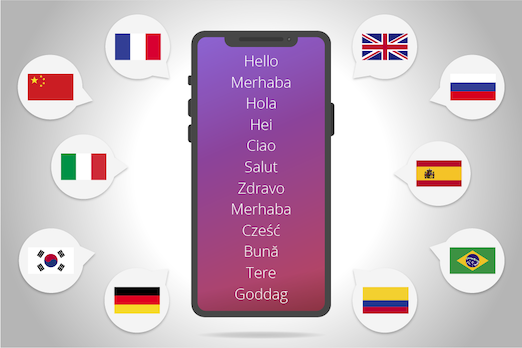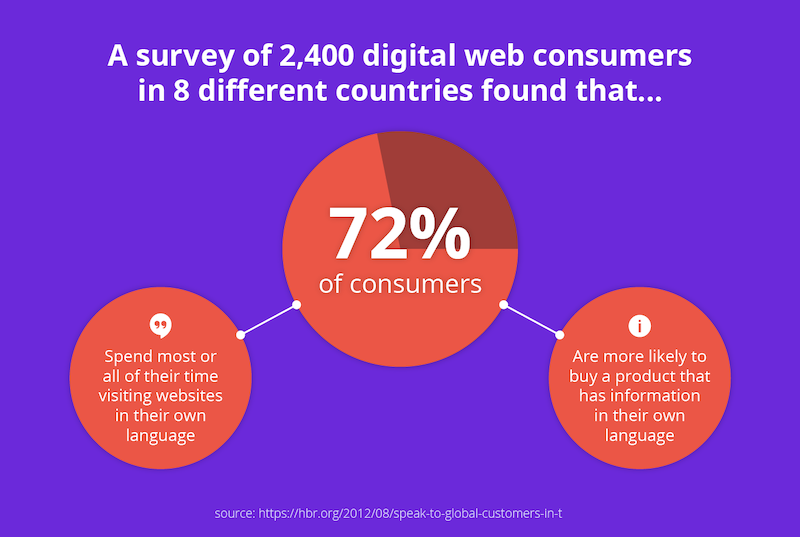How Content Localization Can Benefit Your Company in a Global Market

You’ve played telephone, right?
One person comes up with a phrase, whispers it to the next person, that person whispers it to the next person, and so on. In the end, the phrase has gone through so many iterations that it often no longer resembles the original phrase.
Content translation presents similar challenges.
Simply translating words to a new language fails to consider the different contexts and cultures, and continued translation can result in content that no longer resembles the original content.
Content localization, on the other hand, is an extension of content personalization. It includes translation, but also adjusting content to the culture of the new target audience to create value for them.
Let’s explore how content localization extends beyond translation to drive engagement with a global audience.

What’s The Difference Between Localization and Translation?
Translation is the process of changing a piece of content from one language (the source language) to another language (the target language).
For example, if a company creates an English resource guide, they might translate it into Spanish when the company expands to Spain, and then again into Italian when they target an Italian market.
This approach can shift the message of the content and introduce errors and cultural faux pas.
Translation alone does not consider cultural differences. Content translated to Spanish for Spain won’t have the unique syntax needed for Argentinian Spanish.
Content localization, on the other hand, would create stand-alone content that is technically correct and adapted to the differences in culture, search marketing practices, and legal requirements between the two markets.

Content Localization Goes Beyond Translation
Content localization creates content that is specifically designed for a market by working with local consultants and marketers.
To continue our Spanish example, that would mean local experts would provide different content for Mexico and Spain. Even though these countries both use Spanish as their national language; slang, syntax, and cultural differences remain.
To be successful in selling to a foreign market, brands must overcome more than just language barriers. They must create a customized message, which might include adjusting the following aspects:
- Colors and Font: Content localization considers preferences in colors and fonts for a different audience. For example, in China, white is considered unlucky in some instances. Presenting a person’s name in red font in Korea in the past indicated the person is deceased, or if they were still living that you wish harm to come to them.
- Content Layout: Many factors impact layout. Some languages require more or less space, text may be read left to right or right to left, or the audience may prefer mobile devices. Content localization considers these differences and creates a format that appeals to the audience.
- Images and Visuals: Images and visuals should be changed to appeal to a new target market and location. You wouldn't use pictures of the Brooklyn Bridge on a website targeting London locals, for example.
- Currencies and Measurement Units: Content localization includes changing currency, product descriptions, directions, and any other content that uses currency or measurement to reflect the preferred format of the new market. It may also include raising or lowering the price point based on the new target audience.
- Laws and Regulations: Different locations require companies to meet varying regulations. For example, a U.S.-based company would need to adhere to the GDPR when addressing the EU market.
- Marketing Practices: Effective strategies and competition vary by market. Localizing content may also include adjusting target key terms, link building strategies, and lead generation techniques.
Content localization also addresses the differences in content architecture between locations, including different buyer persona and popular content formats.
Why Does Content Localization Matter?
Consider this scenario: Your company is hosting two conferences about high-end dining—one in Chicago and one in New York.
Your company creates a landing page, brochures, Facebook event, and a visiting guide for each city. The language wouldn't change at all in this example; however, you wouldn't use the same images and content, right?
The speakers might cover different topics, and the conference held in different locations. In Chicago, green might be a fine color choice, but in New York, green could be associated with the New York Jets football team.
You would use Chicago pictures for the Chicago conference, and New York pictures for the New York event. Additionally, your recommended restaurants and directions to the conference location would be different, as would the online strategy you use to sell tickets.
This example highlights the difference content localization can make when it comes to creating content—even when it’s not overseas.
Other big business benefits of content localization include the following:
Overcomes Culture Barriers
To successfully market to a global audience, brands must adjust their marketing message and, in some cases, even their product name, to a new market.
Coca-Cola, for example, is called “kekou kele” in China—which translates to "delicious happiness." Their Chinese marketing strategy included handing out chopsticks and balloons to market the new product. Today, China is the third-largest market for Coca-Cola, selling more than 140 million sodas every day.
Successful global marketing strategy requires adjusting to local cultural norms and creating content and branding that makes locals feel as if the content was created especially for them—because it is!
Increases Sales
When it comes to deciding where to spend their money, consumers are far more likely to spend money with brands that speak their language.
Over half of consumers said that the ability to find information in their native language is more important than cost.

In addition to language, preferences also vary by geographical location. Localization is designed to identify these preferences, then create content that caters to these differences. For example, Italian users tend to prefer a more casual online approach, so localizing content for Italy might include changing the tone and adding humor.
Localized content is effective at increasing sales because it addresses not just language needs, but also different marketing practices and preferences that appeal to diverse audiences.
Builds Brand Loyalty
Consumers are loyal to the brands they trust and feel a connection with. By creating localized content, you are showing a new market that you understand who they are and what they need. This translates to a higher level of brand loyalty, which makes customers less likely to churn.
A lower churn rate results in a decrease in marketing spend and an increase in the lifetime value of your customers.
Increases Brand Integrity
Brand integrity is how consumers perceive your brand based on your content, marketing strategies, and even product packaging. When it comes to content localization, brand integrity can get lost in translation.
In 1987, Braniff Airlines created a campaign to highlight its leather airline seats. An issue arose when that campaign was translated and played on the airwaves in Mexico. The original ad encouraged users to fly "in leather," which sounds nearly identical to "naked" in Spanish.
Localization goes beyond translation to look for conflicts or hidden meanings to help brands avoid faux pas and maintain brand integrity across global markets.
Reduces Customer Support Costs
When customers can easily locate the information they need in a format and language they understand, they are less likely to require the help of your support team.
For example, if an Italian user can find a troubleshooting guide for your product in Italian, they may be able to solve their problems faster, which reduces frustration and prevents a call to your support team.
Content Localization Success: Support Your Content and Your Team With the Right Technology
The most significant challenge companies face when approaching content localization is the sheer size of the project. It can feel overwhelming, which results in many companies choosing to translate content and call it a day.
The issue is, as explained above, merely translating content is not enough to effectively target and convert a global audience. Instead, companies should look for a technological solution that makes it easier to manage the content localization process and reduces frustration.
Contentstack is an omnichannel-ready, headless CMS that offers sophisticated multilingual and localization capabilities. These features allow your brand to create and publish entries in any language and cater to a wide variety of audiences by serving content in their local language. Advanced marketing features also make collaboration far easier with approval workflows, image management, and versioning and rollback capabilities.

Learn from a Brand that's Mastered the Art of Localized Content at Scale
Freeletics, an AI-based fitness and lifestyle coaching app, cut production time for their localized content by 80%. Learn how in our upcoming fireside chat.

About Contentstack
The Contentstack team comprises highly skilled professionals specializing in product marketing, customer acquisition and retention, and digital marketing strategy. With extensive experience holding senior positions at renowned technology companies across Fortune 500, mid-size, and start-up sectors, our team offers impactful solutions based on diverse backgrounds and extensive industry knowledge.
Contentstack is on a mission to deliver the world’s best digital experiences through a fusion of cutting-edge content management, customer data, personalization, and AI technology. Iconic brands, such as AirFrance KLM, ASICS, Burberry, Mattel, Mitsubishi, and Walmart, depend on the platform to rise above the noise in today's crowded digital markets and gain their competitive edge.
In January 2025, Contentstack proudly secured its first-ever position as a Visionary in the 2025 Gartner® Magic Quadrant™ for Digital Experience Platforms (DXP). Further solidifying its prominent standing, Contentstack was recognized as a Leader in the Forrester Research, Inc. March 2025 report, “The Forrester Wave™: Content Management Systems (CMS), Q1 2025.” Contentstack was the only pure headless provider named as a Leader in the report, which evaluated 13 top CMS providers on 19 criteria for current offering and strategy.
Follow Contentstack on LinkedIn.







.svg?format=pjpg&auto=webp)
.svg?format=pjpg&auto=webp)
.png?format=pjpg&auto=webp)






.png?format=pjpg&auto=webp)


